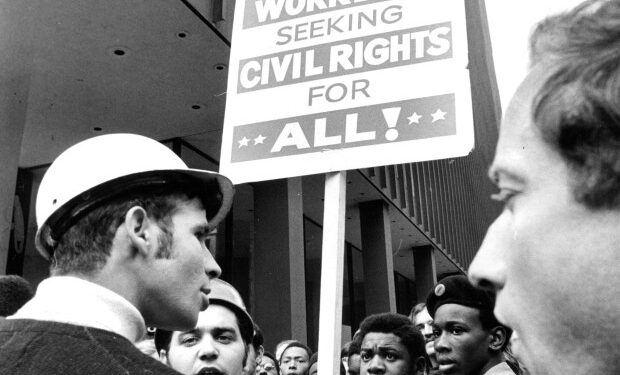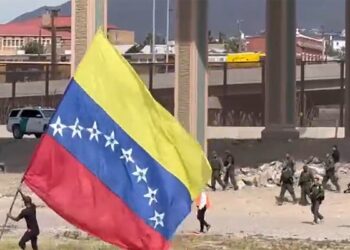In July 1969, a strange scene unfolded outside a building on the 3400 block of Douglas Boulevard: Picketers demanded that a building project be shut down, causing workers to walk off the job. It was a familiar scenario in labor-friendly Chicago, but the players were not the usual suspects.
Picket signs are usually carried by union members protesting an enterprise staffed by nonunion members, “scabs” in the labor movement’s lexicon. But in this case, the project’s workers were union members. Holding the signs were Black protesters unable to get a union card, without which they couldn’t get a job on the project.
The effort to force unions to enroll more Black members continued throughout the summer. After leading a march of 400 protesters to the offices of the Builders Association of Chicago, the Rev. Jesse Jackson said Black Chicagoans were caught in a dilemma. “We have been challenged to work, but we can’t get jobs,” Jackson said.
The picketing in July was organized by the Coalition for United Community Action. The group also mounted a demonstration in the 14th-floor offices of the Chicago Building Council at 130 N. Wells St., vowing “’to halt all building construction projects in Black communities’ until 10,000 trainee jobs are filled by Negroes and other members of minority groups,” the Tribune reported.
On July 30, the Chicago Defender reported that the coalition redeemed its promise by shutting down six West Side construction projects on successive days.
“We’re willing to negotiate,” said the Rev. C. T. Vivian, coalition coordinator, “but it’s apparent the unions don’t since they haven’t.”
By Aug. 9, The New York Times acknowledged that something significant was happening in Chicago: “Twenty major construction projects in Negro areas of Chicago have been shut down within the last two and a half weeks as young Negroes picket the sites in support of demands for more construction jobs for blacks.”
Twenty sites were still shut down when the coalition called for an end to the protests on Sept. 17. The conflict ended in a draw. Neither side got what it wanted.
A week earlier, Ald. William Cousins, backed by other Black elected officials, made a dire prediction: “We’re sitting on a powder keg,” he told the Tribune. “Unless something is done about this in a few days, this city is going to go up in flames.”
It didn’t, but the bitterness lived on. Indeed, it was magnified by neither side being able or willing to see the issue from the other’s perspective.

“As the wife of a trade unionist I went through the four year apprenticeship program on the sidelines,” Norma Knauss wrote in a letter to the editor in the Tribune. She acknowledged the needs of Black residents for jobs, but added that “their so-called spokesmen want everything that the unions fought for and their members paid for since the Industrial Revolution.”
White working-class members saw no problem in carpenters’ or electricians’ children having first dibs on jobs in those trades. Wasn’t that the way things worked?
Colleges and universities often gave preferential treatment to relatives of alumni. So why shouldn’t a white working-class child have a “legacy admission” to the carpenters or electricians union because his father was a member?
Vivian, the boycott’s director, thought the answer self-evident. The Tribune reported: “According to his statistics, four of the 10 major building unions have only one black journeyman, and two have none. Another with a membership of 4,650 has only four, and one with 800 whites has only 3 Blacks.”
The Chicago construction boycott was partially inspired by Washington’s official decision to take a more aggressive approach to problem of chronic unemployment in Black communities. That strategy was laid out in a Tribune story headlined, “Union Chiefs Fear Federal Control.”
“The federal government has moved to eliminate discrimination in hiring by threatening to cut off federal funds and cancel projects where contractors have been found guilty of discriminatory hiring practices,” the Tribune wrote. “Chicago is the prime target for the investigation and labor officials are concerned that unfavorable conclusions will lead to nation-wide sanctions against unions.”

Two months before the boycott, Peter Schoemann, president of the Plumbers Union, said that the only way to avoid a government takeover of unions was to actively recruit Blacks.
But it was too late for that once union workers were picketed on Douglas Boulevard. A war of words mutated into street battles and sit-ins.
With emotions running on overdrive, there were threats and act of violence in a racially divided city.
“A group of nearly 100 Black youths arrived at the site of the new 15-million-dollar science and engineering building at Polk and Halsted Streets shortly after 8 a.m. and demanded that workers leave the project and the site be closed,” the Tribune reported of a clash at the U. of I.’s Circle Campus on Aug. 12 that led to seven arrests. “A brief scuffle broke out when police stepped in to prevent protestors from breaking into the construction site.”
Two weeks later, Black demonstrators described by the Tribune as “militants” interrupted the Illinois convention of the AFL-CIO in the Congress Hotel. Meredith Gilbert, the group’s leader, pushed aside the union’s president and shouted: “This convention has ended.”
Meredith was ordered to get off the speakers platform because wasn’t a delegate. “I am now,” he replied. “Try to make me get off.”


Union leaders had sent a resolution to the convention urging support for people of color trying to get into the building trades. It was drafted by Charles Hayes, a Black officer of the Amalgamated Meatcutters union, who afterward acknowledged his effort wasn’t enough.
“Informed of the disruption on the convention, Hayes, who has worked closely with the coalition and civil rights causes, said ‘Sorry. I’m sorry,’” the Tribune reported. “It wasn’t as strong as I would have liked it to be, but it was a good statement.”
Among those at the convention were Ralph Abernathy, who had taken over as president of the Southern Christian Leadership Conference following the assassination of Martin Luther King Jr. a year earlier.
Mayor Richard J. Daley seemed reluctant to intervene, perhaps because he was stuck between a rock and a hard place: Unions were prominent in Chicago’s political establishment. But Black voters kept him in office.
On Sept. 8, a march on a Circle Campus construction site ended in a melee when rocks and bottles were thrown at police officers. Among those arrested were Jesse Jackson and Leonard Sengali, a leader of the Black P. Stone Nation, a street gang that was part of the coalition.
“We can’t lose, we’ve got soul power!” Jackson shouted to the crowd as he was led away. Earlier in the day, he had been honored as one of Chicago’s 10 outstanding young men during a Palmer House luncheon.

The demonstrators included “at least 10 Blacks with German shepherds and Doberman Pinschers,” the Tribune reported.
Union activists found it difficult to accept gang members, who purportedly had turned their attention to civil rights causes, as partners in resolving the construction work stalemate.
On Sept. 18, the Chicago Defender reported a letter was being circulated by the International Brotherhood of Electrical Workers that said federal officials were advising that “it would be prudent” for the union to deal individuals associated with the Black P. Stone Nation, Vice Lords and other gangs, because if not jobs involving federal funding could be shut down.
Earlier that week, Mayor Daley invited the unions and the Coalition to resume negotiations at City Hall. A tentative agreement the provisions of which called for the immediate hiring of 4,000 Black workers for journeyman positions or for apprentice or pre-apprentice training failed to gain traction.
The boycott ended without any concession to Blacks seeking jobs, and the conflict continued. The unions ignored a Tribune editorial’s suggestion that a reasonable counter-offer could quell the summer-long discontent: “If they prove they are sincere about ending years of discrimination, they will earn the support of fair-minded Blacks and the militants will be left shouting at an empty room.”
Have an idea for Vintage Chicago Tribune? Share it with Ron Grossman and Marianne Mather at rgrossman@chicagotribune.com and mmather@chicagotribune.com







